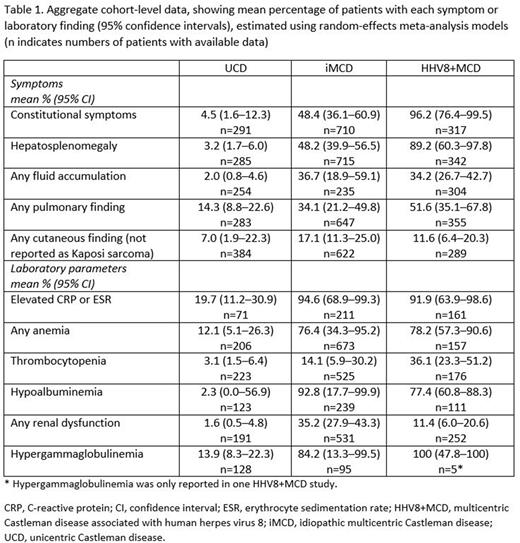Abstract

Background: Castleman disease (CD) encompasses a spectrum of rare disorders with characteristic histopathologic features. It is important to distinguish unicentric CD (UCD) from idiopathic multicentric CD (iMCD), and to identify MCD associated with human herpes virus 8 (HHV8-positive MCD). Diagnostic guidelines are available for both UCD and iMCD, but not for HHV8+MCD. The aim of this study was to compare the clinical presentations of these different CD subtypes.
Methods: A systematic review was performed of all publications following the PRISMA guidelines to identify publications reporting on ≥5 patients with CD between 1995 and 2021. For each type of CD within each study, we extracted data on patients' demographics, clinical symptoms, and laboratory parameters, as stated in the 2017 international consensus diagnostic criteria for iMCD. As many of the included studies were published prior to these criteria and precise clinical and laboratory data were not reported, we extended the criteria to capture symptoms and laboratory parameters beyond the ranges defined in the consensus diagnostic criteria. We then estimated the mean percentage of patients meeting each diagnostic criterion for each CD subtype using meta-analyses conducted with random-effects logistic regression models to account for between-study heterogeneity.
Results: A total of 47 studies were included in the analysis, including 32 studies (n=2055 patients) with aggregated cohort-level data and 15 studies (n=335 patients) with patient-level data. Not surprisingly, the aggregated cohort-level data showed that patients with UCD had lower rates of symptoms and laboratory abnormalities than those with iMCD and HHV8+MCD. Many symptoms and laboratory abnormalities occurred at similar rates in patients with iMCD and HHV8+MCD. However, renal dysfunction and potentially hypoalbuminemia were more common among patients with iMCD versus HHV8+MCD, while constitutional symptoms and hepatosplenomegaly were less frequent (Table 1). Analysis of patient-level data largely confirmed these findings.
Conclusions: This systematic review revealed that some systemic symptoms may be present in patients with UCD. We found many similarities among the clinical presentations and laboratory findings in patients with iMCD and HHV8+MCD, but also some important differences. These differences probably reflect the heterogeneity of the underlying pathophysiology and/or the different comorbidity burdens of these MCD subtypes.
Disclosures
Kanhai:EUSA Pharma: Current Employment. Littler:TVF Communications: Consultancy. Grant:TVF Communications: Consultancy. Hoffmann:Janssen-Cilag: Honoraria, Research Funding, Speakers Bureau; EUSA Pharma: Honoraria, Research Funding, Speakers Bureau; Gilead Sciences: Honoraria, Research Funding, Speakers Bureau; MSD: Honoraria, Research Funding, Speakers Bureau; ViiV Healthcare: Honoraria, Research Funding, Speakers Bureau.
Author notes
 This icon denotes a clinically relevant abstract
This icon denotes a clinically relevant abstract
Asterisk with author names denotes non-ASH members.


